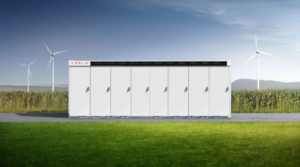Large California businesses are adopting energy storage at a record rate! Many of these companies installed solar panels in the past and were still left with hefty demand charges on their electric bills. Commercial electric utility customers pay both energy charges (the cost for kwh used in any given month) and demand charges (the cost for how many KW the facility used in any 15-minute interval during that month). While solar panels help reduce the kwh a business uses (thereby reducing the energy charges) commercial battery energy storage can help reduce the KW the facility pulls from the grid (thereby reducing demand charges).
Reduce commercial demand charges with commercial battery energy storage!
When large commercial energy consumers like manufacturers, sports stadiums, and cold storage businesses utilize equipment or turn on their facility at peak hours during the day the local electric utility must turn on fossil fuel “peaker plants” to meet the demand needed. The electric utility charges the business for this demand, which is punitive based on the highest threshold in KW reached that month (or in some cases that year). By installing commercial battery energy storage, a large business or facility can store their own clean energy on site and pull from it during these times of high grid stress. In addition to saving hundreds of thousands of dollars commercial battery energy storage will provide more resiliency to the business and help reduce carbon emissions.
Incentives:
The state of California incentives the installation of battery energy storage with a one-time cash rebate (SGIP). In addition to this lucrative incentive the new infrastructure bill that Congress just passed includes a standalone 30% investment tax credit for all energy storage projects.
Case Study:
Let us walk through an example of a commercial battery energy storage project I recently consulted on. The facility we were analyzing to install this technology at is a sports stadium for a well-known university in Los Angeles. They had already installed a solar system on top of the stadium and were still incurring annual demand charges from LADWP in the amount of $250,000 per year. We proposed a Tesla megapack that would save them $97,800 per year! The gross turnkey cost of the project was $1,327,000 and the university would receive $840,307 in state and Federal incentives bringing their net investment down to $486,693. This means the project return on investment is 4.97 years!
Next Steps:
Want to see how much money your business, corporation, or organization can save with a commercial battery storage system? Get your turnkey commercial solar and battery storage proposal with ROI and financing options by e-mailing us your last 12 months electric bills (all pages), a picture of the electrical switchgear inside of the facility, and a picture of your roof today: info@beachcitiessolarconsulting.com.


